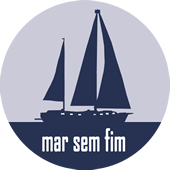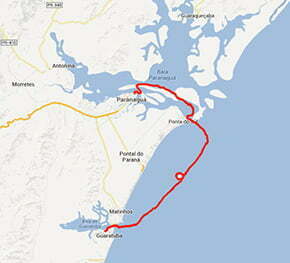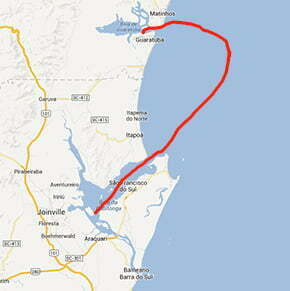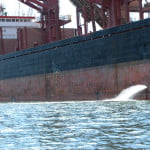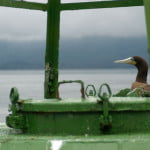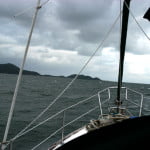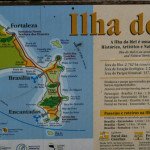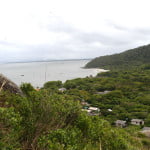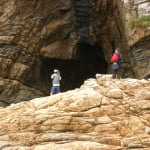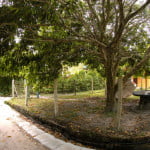Monday, 27 – 11 – 2006.
The plane took off at midday. We landed in Curitiba 40 minutes later. We had barbecue for lunch and afterwards a talk at the Federal University.
We interviewed Professor Marcia Marques who teaches Ecology at Parana’s FU and wrote the book “Natural History and the Conservation of the Mel Island”.
The weather doesn’t help us. The sky is cloudy, gray and dark. Joselia Pegorim assured me that the weather will start to get better on Wednesday and “it shall be better on Thursday”.
I haven’t even made comments on the meeting I mentioned in Iguape’s logbook. It worked out well. We can count on Colgate’s support, our new sponsor. From this trip on, an additional sticker has to be put on the hull of our sailboat. This is a good task.
I asked Marcia what was special on the Mel Island that made her devote herself to the study of the island and publish a book on it.
The beautiful young skinny professor explained that what attracts her the most is the reef. According to Marcia, there are just a few reefs today in Brazil. “Since these areas are flat, near the sea, speculation affects them first.”
70% of the Mel Island is covered by plains with reefs. Here they have been protected since 1982 when it became a State Ecological Station. Marcia tells us enthusiastically that most of the reefs of the Brazilian coast have vegetal creeping formations, with bushes, but just that. Here, on the contrary, the reefs have a more developed forest formation with trees which are 20 meters high.
The most important activity on Mel Island is tourism; you can hardly find traditional communities. Marcia says that just a couple of old fishermen are found here; the rest deals with tourism.
The island was “rediscovered” by the hippies in the 70s. And then, in the 80s, came the backpackers and campers who used to stay at the local inhabitants’ houses. And then speculation arrived. Once again, properties were sold at very low prices. New hotels and pousadas were built and today most of them are owned by people who are not from here. There are nine thousand beds available. In spite of never having visited the island, it is a surprising figure. I think it is difficult for a fragile environment like this to stand such a big daily impact.
After the end of our talk, we went down the mountain by taxi to Paranagua, where the Endless Sea was. An hour and a half later in the rain we were on board again.
The weather is worse here. There is wind from the south and it rains hard.
Fortunately, we are not going to sail tomorrow. We have more interviews scheduled.
Tuesday, 28 – 11 – 2006.
Early in the morning, we went to the Sea Studies Center from Parana’s Federal University which is near Paranagua, in Pontal do Sul.
A room had been booked for the Endless Sea’s team and all the teachers and PhD students were at our disposal. We arrived early and left late. We interviewed four experts. We learned a lot, as usual.
Fabian Sa is preparing his PhD in Environmental Geochemistry and told us about the contamination in the bay of Paranagua with heavy metals, arsenic and nickel. He realized that the two substances had levels beyond those of the Conama Resolution which deals with this issue. Currently, he is trying to find out their origin. There are many hypotheses since one of Brazil’s biggest ports is here and dredging is made every two years; additionally, you can find Petrobras’ refinery, plants, shipyards, cities, agriculture (and pesticides) around, etc.
His study is recent and new. That’s why, according to Fabian, it is more difficult to determine standards or compare and define the acceptable level of contamination “since it is the first time that this type of evaluation is made.”
I asked how the port would be prepared to deal with accidents which may occur and are normally serious in this activity. He smiled and answered in accordance with our expectations: they have no plans, equipment, nothing. He told us that when Vicunha, the ship, exploded loaded with methanol a year and a half ago; the fuel extinguished itself with fire almost two days after it started to burn. During the situation, very little was done by the port authorities; they just observed impotently how the situation evolved.
Unfortunately, accidents in Paranagua occur quite often. From time to time, newspapers bring the news. Two or three weeks ago, there was one more vegetal oil leakage. When measures are taken, they are insufficient and ineffective. This is what happens in one of the most important bays of South Atlantic’s estuary complex.
On our last trip, when we arrived in Paranagua, we first went around the port. As usual, there were several ships docked and many others waiting anchored in the bay. When we were sailing in front of the platform, we saw one of them with four powerful pumps operating, expelling ballast water while the ship was loaded. Simply that! In the middle of the port.
I asked the teachers what their opinion was on bio-invasion in the bay of Parangua. All of them, without exception, confirmed several cases. Unfortunately, the expert on this issue was not on the campus today, and the others didn’t want to make comments on a subject they don’t know very well. Nevertheless, it was possible to hear about an exotic mussel which is replacing the local ones on the rocky coast of Mel Island as well as about the algae proliferation in the bay and some strange fishes which have been caught recently and haven’t been identified yet.
In Brazil’s coastal waters, today the major problems are pollution and bio-invasion. Both act like a cancer: they occupy the maritime organism in a sneaking way; that is, in its richest portion in terms of nutrients and ecosystems. 90% of the proteins that we consume come from the sea. And the maritime life chain starts precisely in coastal waters.
But this is not the end of the list of problems. I must mention here the lack of basic sanitation in the surrounding cities.
Paranagua has 127 thousand inhabitants who live in 34,500 houses. 69% have waste system. Antonina, has 19 thousand inhabitants who live in 5,600 houses but only 32% have waste system. Guaraqueçaba is the worst situation. 8,000 inhabitants live in approximately 2,100 houses, but only 5.4%, that is 115, have waste system. (Source: IBGE 2000). During the high season, these cities and a couple of other cities in the surrounding area receive three, four times as many tourists; and the dirt is highly multiplied. Everything goes to the sea.
We also talked to biologist Claro who also studies on Mel Island. He agrees that it is a huge amount of tourists who come to the island. He also said that the number was “limited” to seven thousand per day; however, at the peak of the summer, they are 10 thousand!
I asked about the Park’s Management Committee, but he was not very enthusiastic. Native people have no representatives. They gave up. Many plans were presented but just one offers working with the communities. Nothing is offered professionally, they find themselves in an underemployment situation.
According to Claro, one of the major problems is garbage. Sixty pousadas send it to the continent. 1,500 local inhabitants divided in 4 villages keep their garbage there.
Next we talked to another expert, Rangel, who explained to us about Guaratuba which we will be visiting soon.
Our last interview was with Professor Frederico Brandini who has an interesting project of spreading artificial habitats (artificial reefs) all over Parana’s coast. These habitats will at the same time refrain big professional boats from trawl-net fishing.
This is one more brutal pressure on the most productive part of our coast. We have denounced trawl-net fishing since our trip to Amapa. Sometimes, you can see it at less than a mile from the coast!
Brandini spoke emphatically about the damages of this and other types and intensity of professional fishing.
When I asked him about the health of the seas, he got excited, all red. The veins in the neck were swollen as if they were about to explode. And Brandini was decisive: very bad. He repeated with emphasis: very bad!
It was a fruitful morning. We are ready to sail, we are just waiting to have a better weather. Last night it rained all the time and a lot. Today, at first it looked better and then it got bad again. Let’s see tomorrow.
Wednesday, 29 – 11 – 2006.
I got up late, this rarely happens in our routine during the trips. I got up at 10:30 a.m. We didn’t have much to do, only recording a series of passages for the previous program which is already ready in São Paulo. The rest of the day would be free.
I had breakfast slowly and then we got on the support boat.
The first recording would be on legendary Joshua Slocum’s shipwreck in 1887, in the bay of Antonina.
It took us 20 minutes to reach the entrance where we shot the images.
I told you how Slocum overcame the situation after he lost his ship and wrote one of the most beautiful pages of the world’s navigation. He didn’t complain or curse; with resignation and confidence he entered in the Atlantic forest and chose the best trees. Afterwards, he carved it and little by little he built a new sailboat, 35 feet long, with plenty of modern technical innovations for that time. He used only an axe, two saws, an adz and a file; the only tools left after the accident. The hull was similar to that of Brazilian canoes which he admired a lot as well as that of Santa Ann’s fishing boats, from the U.S.A. It was armed like oriental sampans, with sails easy to handle, light and simple, sewn by his wife. To avoid overturning, Slocum put on the edge of both sides of the broadside giant bamboo stems which serve as air bags, making the overturning difficult and if it happens this helps to make it stand again.
He launched his boat on May 13, 1888, and to pay homage to the special date, the boat was given the name “Liberdade”, in Portuguese. 55 days after the beginning of the trip to Paranagua, after having sailed five thousand miles with his wife and children, 14 and 5 years old, Slocum arrived in his homeland, Washington, with his Liberdade. The Endless Sea had to pay tribute to this important sailor, an inspiring myth.
Afterwards, we sailed to the entrance of the bar of Paranagua where I was going to shoot two parts. The weather looked better at first and then it was bad again. There was a thin rain. We returned to the Endless Sea, our shelter.
Paulina prepared the editing material and then we went to the post office to send it by mail. And the last and most boring thing, the supermarket. Eventually, we got on board.
It was late when everything was ready, we wouldn’t have enough time to arrive at day light. We will leave in the early morning.
Before going to bed, something unexpected happened: the camera broke. This was the second time, since we started the program, it has been the same. On the departure day, at the last minute, just before leaving, the camera breaks. Here, in Ilheus, always the same. Well, it helps to think that fortunately it happened here where it can be changed. But this means one lost day.
Thursday, 30 – 11 – 2006.
Early in the morning, Regina, who backs us up in São Paulo, was calling to tell us what to do. The other camera was going to be brought by Andrea, the producer, on the same flight we took. We had to be in Curitiba at the flight arrival time to meet her and change the equipment.
It was 4 p.m. when we finally got on board. One more time there was thin rain and south wind.
At 11.30 p.m., I organized my logbook. It is good to be able to write based on facts, memories and impressions. It’s much easier.
The sailboat is going sideways. We anchored at Saco do Limoeiro, at Mel Island, behind the end where the lighthouse is. The south, southeast wind blows at 20, 22 knots. And we are not really protected.
We are in the most prominent part of the island towards the sea, in the mouth of the bay of Paranagua and the waves arrive without any barriers.
Noises are unbelievable in the cabin. The interior of a sailboat is like an echo chamber. Cracks, creaks of different types, pans hitting one against the other, cables scratching the mast, water against the broadside, the wind whistling on the backstays… From time to time, a jolt makes me stop writing or correct the wrong letter I’ve just typed inadvertently.
It is cold and wet outside. I’ve just closed the entrance hatchway. The stern pushed by the ebb tide now faces the rain.
It is hot in the cabin, noisy; the floor and the walls are completely irregular. They can’t stay still.
But I like this atmosphere.
Friday, 1 – 12 – 2006.
Today the sun showed up a little bit. There are still a few clouds, some of them quite heavy, others not. As we were walking in the neighborhood of Encantada village, squeezed between two hills, showing clearly the absence of a city plan added to a chaotic growth, rain in distant areas could be seen.
We walked a lot. From 8.30 a.m. to 2 p.m.
Going up and down the hills. When we first got off at Encantada, we crossed the entire village until we reached the grotto with the same name, at the end of Fora beach. And then we continued northwards until the next one, Miguel beach.
We returned to Prainha where we got off and with the support boat we visited one of the four other villages called Brasilia.
One more time we walked around the peninsula and then along Conchas beach until the lighthouse built by D.Pedro II, in 1872. The various ecosystems of the island call our attention all the way: small dunes, beaches, a beautiful and exuberant reef, rivers, lakes. The Mel Island is really wonderful. It is not for any other reason; it is the second most important tourism area in Parana. However, public authorities are not as careful as they should. The first anchorage for boats was built only in 1996. It’s not a joke!
We finally returned to the boat. Before having lunch, I’m going to see the result of this morning’s pictures. Afterwards, if there’s enough time left, we will leave the boat again.
We didn’t have enough time. In fact, we did have time left but we didn’t feel like leaving the boat. We were starving; we spent lots of energy on the morning activity. We had a wonderful barbecue: “bife de chouriço” (a typical Argentinean meat cut), rice and potatoes. We also had wine. And then we went to bed.
I woke up a few minutes to midnight; I was thirsty and looking for some coke. Paulina was finishing her reading in the cockpit while Cardozo was preparing his bed. I woke up and they are going to bed. There isn’t much wind and it is a starry night. There will be good weather tomorrow.
Saturday, 2 – 12 – 2006.
We started sailing to Guaratuba , 22 miles southwards, early in the morning. The sea was agitated. It has blown hard these days. We left the bar remarkably. The area is quite low and unprotected. Any type of wind makes significantly high waves; that’s the reason why we go through the canal which leads to the port and is delimitated with buoys if we don’t want to ground. In the middle of our way we looked back and saw a huge ship which was leaving at the same time. We will have to make way; it is much faster than ours. It was a tense situation. Before the penultimate buoy, the huge iron mass was at our stern. I altered course and left the monster pass. The Endless Sea was shaking like a tumbler, punched by a furious child.
This was the only remarkable thing that occurred during our sailing.
A few hours later we were in front of Guaratuba’s bar. Waves were breaking everywhere. We looked for the access canal but couldn’t find it. One more non-delimitated dangerous bar. It’s unbelievable. We are a maritime country which turned its back to the sea. From Amapa to where we are now, we have noticed the inevitable: there is no facility or infrastructure for the nautical activity which would bring with tourism a few million dollars for coastal cities, if it had the necessary minimum.
An enormous amount of people sail with small boats all over the world. Our country has a wonderful coast, no hurricanes, ground swells, tsunamis and things of the sort. Our currency is cheap compared to dollars or euros. However, in addition to the lack of infrastructure, many times even for a miserable cargo there is no available marina and when a foreign boat arrives in our waters, it is allowed to stay at most three months. This makes the international community which sails throughout the world avoid our eight thousand kilometers of exuberant coast. Not even fishermen who work here are safe in their professional activity. What do we pay taxes for and why?
Well, this being the case, I used the board radio and started to call any vessel in the bay which could guide us in the entrance. It didn’t take us long to have an answer. Someone heard my call and gave us some guidance. Despite the explanation, we couldn’t find the entrance. I was about to give up and return when a motor boat came to our direction. It was Sunrise from Caioba Yacht Club. The sailor, the owner and his son were on board. They were kind enough to come and fetch us. We entered and faced huge waves, always at a depth superior to three meters.
The bay of Guaratuba is small compared to Paranagua’s. The estuary has “just” 52 kilometers and according to Rangel Angelotti from Parana’s Federal University, the major conflict and pressure here is the population growth in the neighboring cities. As usual, basic sanitation is insignificant; the cities’ chaotic growth is constant, and “public authorities, who never have time for planning, go after it and try not to loose much”, this is professor Rangel’s definition.
He also told us that working here made him understand that it takes nine days to renew the water of the bay. Due to its size and mouth, this is the minimum it takes to have a natural salutary cleaning. While this is not possible, the bay is full of urban pollution. Guaratuba has 27 thousand inhabitants living in 7 thousand permanent homes. Only 19%, or 1,400, have waste system. As usual, on holidays and vacation, the population is three times as much. Rangel explained to us that in the last 50 years, there has been a very significant change in regard to the characteristics of the population. In the past, 80% was rural. Today, it is just the opposite: 80% of the population is urban. In spite of that, according to the professor, “the inner part of the bay is well preserved, the great pressure comes from nautical clubs, summer houses, marinas, etc and this occurs in the mouth”.
They have already tried shrimp breeding here. They used Vanamei from the Pacific like they did in the Northeast. Many were sold as bait for fishing fans. Fortunately, according to Rangel, Ibama, refrained them from continuing the activity.
Nowadays, in regard to crustacean culture, oyster breeding and handling have developed here. There are many farms where this activity exists.
I asked Rangel what he thinks about the preservation of the maritime environment. “It seems common citizens have changed but not radically.” He concludes: “Everybody wants to preserve the environment, but nobody gives up the idea of having a house on the beach or changes his consumption habits.”
He criticizes the model of parks adopted in Brazil: “We copied the old-fashioned American model, which insists on the myth of untouched nature.” He continues with his sharp comments: The preservationist policy removes from the delimitated park areas people who are highly sensitive in regard to nature cycles or those who are experts on the pharmacological property of plants and herbs.” He concludes: “What really affects is the lack of qualified public agents who are most of the time politically chosen.”
I fully agree. Tomorrow we will start to explore Guaratuba. There isn’t enough time for that now.
Sunday, 3 – 12 – 2006.
We would like to know the bottom of the bay, its more preserved area, richer in life and vegetation. We anchored the Endless Sea in the back of the city of Guaratuba and got off the boat to look for a pilot. We were going to use the motor boat, we needed someone who knew the area on board.
A few minutes later they recommended a 19 year-old young man, an expert, who had lived in that area. Adriano was going to spend the day with us. We wanted to arrive at Parado lagoon after the river which has the same name, one of the thirty rivers that form this bay. Professor Rangel told us to visit it; he spoke about the beauty of these “mini-lowlands” of Parana.
The prow of the boat was directed towards the interior and we speeded up. The bay is wonderful, marvelous, surrounded by mountains and Tabaquara, near the mouth of the bar, is the most imposing. I asked Adriano about fishes. His answer was offering me more than 10 robalos which were in his house for sale. “Fishes have always been available and they will always be; the thing is that more fishes are being caught.” Here is a proof of the young man’s intelligence. He understands what overfishing is.
When we were about to arrive, we started our way up the Parado River. Marvelous. Probably, the most beautiful we have seen so far. We went about 50 minutes up, sailing at about 20 miles; at first with mangroves around and then surrounded by a thick ciliary forest, with huge trees whose trunks had thousands of huge bromelias.
Here and there you can see areas of vegetation which had been devastated for agriculture where there were pasture and cattle. Adriano told us there are many buffalo farms.
As we get closer, the water is fresher and colder. The vegetation is higher and there is a great variety. The bed of the river gets narrower and the river course has such a sinuosity that it twists like a snake; it is very funny. Sometimes, it looks like a carrousel. The angles get closer. From time to time you see elbows, or curves over 300 degrees, and everything around has different live and fantastic shades of green.
It is irresistible; I stop the motor several times for a while so that silence make us hear the various and different sounds of birds. Adriano finds out what the sounds are and starts to chirp. In a few minutes he imitated half a dozen birds from the forest. With no instruments, only with his hands and lips. It is beautiful. He knows this art remarkably and a lot of simple life; he knows the “cycles of nature” deeply. The cultural and animal biodiversity is fantastic. We heard the answers; sounds echoing in the fabulous scenery around. This will be one of the most beautiful episodes of the series. It will be the last of the year. If we reach the audience record of five points (we have already reached 4.6) we will reach it with this program with plenty of beautiful scenes.
After having gone up significantly and at the end of a curve, there were several huge fishing boats anchored weighing 20 tons or more.
Adriano explained to us “scholars” that during the closed season, many fishermen bring their boats where there is fresh water to kill maggots which penetrate the wood, grow and proliferate in salt water. That’s why during these calm months the boats are brought here. When they start fishing again at the end of the period, this plague has gone away.
We kept on going up until we saw typical formations of fresh water lagoons, similar to lowlands. However, there was still a long way left; additionally the water vegetation was very thick and was almost covering the canal. The canal was deep enough; sometimes over two meters, but extremely narrow. Leaves were caught by the motor propeller which refrained us from going ahead. It was necessary to lift the revolving rod with our hands to free the blocked propeller.
I decided to return. If we continued, we would probably spend the night there and be eaten up by mosquitoes. On our way back, at a cruiser speed, suddenly Adriano tells us to slow down. He told me to stop. I obeyed out of curiosity. He had seen a jaboticaba tree full of fruits and found it irresistible. He got off the boat and disappeared in the thick forest. A few minutes later, he got back with a bag in his hands full of fruits which looked like jaboticabas but they were as big as figs. Delicious, as sweet as honey. We gorged ourselves on them.
While we were eating the natural banquet, I thought about the fast, chaotic and sometimes destructive occupation of the coast imposed by several generations. It was hard to realize that many wonderful and rich places like that had already been devastated.
How many centennial native jaboticaba trees had been cut down to make us believe that the tree and the fruits we had found were so special?
And then that reminded me of the book I’ve bought by great geographer Aziz Ab’Saber : “Brasil: Paisagens de Exceção” (Brazil: Landscapes of Exception). I brought it to read it on the trip. Yesterday, I read the book jacket written by Reinaldo Correa da Costa. I liked it. It is brilliant and sharp. A paragraph called my attention. The writer had just mentioned that today tourism was very voluptuous on the Northeast coast (or in the lowlands) and it always requires original landscapes. When the two landscapes of exception (the lowlands and the coast) are mentioned, based on keen knowledge about Brazil, the writer says wisely and in a subtle way that an ethical reflection on these landscapes of exception is required. “Not only to be careful with the spaces inherited from nature, seeing that the landscape is an INHERITANCE (I wrote it with capital letters) both of geomorphologic and biotic processes combined with the history of mankind; but it is also a COLLECTIVE PATRIMONY (idem).” He concludes further: “To interfere in a better way, it is necessary to learn about the landscapes; it is unethical to plan interference on the landscapes just thinking on the surplus value of the land and forgetting old local inhabitants with their way of living based on ethnoknowledge.”
Sun vanished a long time ago. Daylight is over. It is past 10:00 p.m. We have just been visited by Adriano in his baleeira. He came spontaneously just to give us two fishes. He didn’t want to come to our boat. And then he disappeared in the dark to take care of his net.
Monday, 04 – 12 – 2006.
Our yesterday’s sailing finished late; after we visited Seu Vicente’s oyster breeding beside the restaurant he owns with his wife, Santa, on Braço Seco Island. We got off for an interview. Afterwards, we tasted the restaurant’s special dish: oysters au gratin. Before, we had a delicious crab. A contest of the best crab offered on the coast is worthwhile: Guarequeçaba’s, Antonina’s or the crab we have eaten here? Difficult task.
In spite of the tiresome day we had, I couldn’t sleep at night. We were literally attacked by a flotilla of minute insects. Some of them could go through the mosquito net. Goddamn. There will be full moon. That’s why they were here. It was extremely hot and raining. After scraping my back due to intense rubbing, I covered my whole body with a blanket and just my feet were uncovered. It went on all night long, the palm of my hands and the sole of my feet were bitten. How come? This reminded me of the first nights in the Oiapoque River in front of the district. It was a hell like that.
This morning the weather was gray and it was raining, just for a change. I slept a little bit in the cockpit until midday or so. My back was covered by wounds and I had itches on my front. My whole body had been attacked. We went to the city to record images at lunch time. Afterwards, Cardozo and I sailed with the boat. We returned at the end of the day. We are going to sail to São Francisco do Sul tomorrow. We are going to explore the coast of the penultimate coastal state out of the seventeen Brazil has: Santa Catarina.
Tuesday, 05 – 12 – 2006.
Before dawn, we lifted the anchor and went to the dangerous bar at full tide.
Just before crossing it, I used the sound and with the VHF radio in my hand I went ahead in order to warn Alonso about the depth.
We crossed it. And then I got on board and the motor boat was pulled.
We sailed calmly during the 25 miles which separate Guaratuba from São Francisco do Sul.
At our arrival, we found it difficult to see the buoy which delimitates the entrance canal; nothing serious.
A few minutes later, we anchored in front of the National Sea Museum where the old city port was.
This is the only Latin American museum which is designed to preserve the naval culture and the typical vessels. The museum has approximately 50 types of Brazilian traditional boats. A wonderful thing we will know better during our next trip.
In the afternoon, we left the boat and went to Joinville where we took the plane to São Paulo.
As soon as there is better weather, my faithful squire, Alonso, will take the sailboat to Florianopolis where it will be for the holidays of the end of the year.
We will start our trips again next year.
